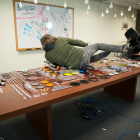sentryGun53
Member Since: January 3, 2011
Country: United States
-
The matrix is a system, Neo. That system is our enemy. - Morpheus
-
I would make a capacitive QWERTY keyboard layout, with a small pad for each key. Something that could be unrolled onto any surface and used as a keyboard (or number keypad). Since the material is not only flexible, but clear as well, you could glue an EL panel to the back of it, and have a flexible, super-thin, backlit keyboard! Reminds me of Tony Stark's keyboard. Or, you could stick this capacitive keyboard/keypad to a glass surface (eg. coffee table, car window) for a touch-sensitive overlay.
Now that I think about it, capacitive touch sensing can be touchy, so in the spirit of spectra symbol, you could use the same materials that are inside the softpots, for resistance-based sensing instead.
Also, krdarrah1234 has already mentioned a shoe insert, which was one of the first things that came to mind. Check out the Adidas Megalizer shoes (I'm not usually an e-textile guy, but this stuff is pretty cool): https://www.youtube.com/watch?v=p0LtpDFxHCQ
-
it's all fun and games until your Simon kit evolves
-
Took me a bit to find some good references for this board, here's what I found:
Library for Arduino - works great with this module
Video tutorial on calibrating the module - uses the above library
Another note: I'm using this to replace the HMC6352, which is not tilt-compensated. The HMC6352 had a nice north-indicator arrow screenprinted onto the PCB, but this LMS303 board lacks that indicator.... So, to draw it on yourself: hold the board flat in front of you, with the chip on top, and rotate the board until the "SA0" marking is properly readable to you. The north-reference arrow should be drawn to point exactly towards the right-hand edge of the board.
Hope that helps somebody else using this board!
-
So much OSHA-approved goodness
-
This ladder matches my fur... all the ladies are staring.
-
Solder it vertically, they said. It'll be fun, they said.
-
Worked great, thanks!
-
I see that the settings are saved on a battery-backed RAM on the device. Is there a way to factory reset the module, perhaps by temporarily removing this battery?
-
While trying to change the baud rate of this module, I think I mistakenly set the protocol to SiRF by sending this command:
"$PSRF100,0,19200,8,1,0*39\r\n"
Now, I can't get the TinyGPS library to read the incoming data at either 19200 baud or the default 4800 baud (which was working fine before I sent the command).
How can I set this back to NMEA at 4800 baud?

















